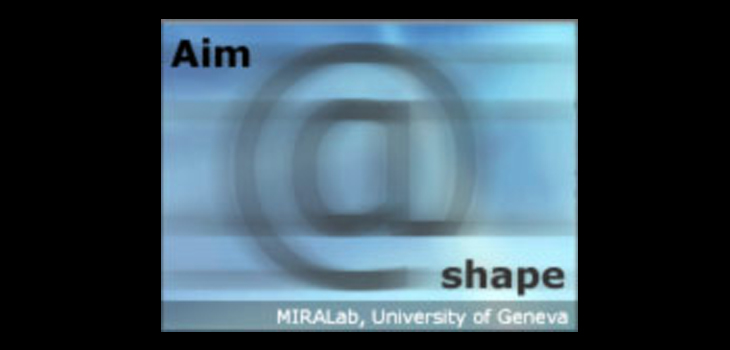
AIM@Shape – “Advanced and Innovative Models And Tools for the development of Semantic-based systems for Handling, Acquiring, and Processing knowledge Embedded in multidimensional digital objects”
Overview
The mission of AIM@SHAPE is to advance research in the direction of semantic-based shape representations and semantic-oriented tools to acquire, build, transmit, and process shapes with their associated knowledge. We foresee a new generation of shapes in which knowledge is explicitly represented and, therefore, can be retrieved, processed, shared, and exploited to construct new knowledge.
This new approach in shape research is to be created by:
- the formalization of shape knowledge and the definition of shape ontologies in specific contexts
- the definition of shape behaviors which formalize the interoperability between shapes
- the delineation of methods for knowledge-based design of shapes
- the definition of tools for semantics-dependent mapping of shapes.
This scientific goal of AIM@SHAPE is ambitious, and it can be achieved only by establishing the infrastructures necessary for growing a new multi-disciplinary research field, where excellence in Computer Graphics and Vision, Computational Mathematics, Geometric Modelling, Computer Science, CAD and Engineering, joins state-of-the-art Knowledge Technologies. The scientific innovation sought by AIM@SHAPE will be high in terms of the new methodological approach to model digital shapes. Current information systems may handle the geometric representation of digital shapes, but not their semantics “meaning or functionality) in a given context. Scientific innovation will be also high in terms of proposing and developing ontologies for modelling digital shapes and their semantics in key applied sectors. Up to now, the efforts in this direction only touch the visual appearance of 3D objects “geometry) but not the meaning of the shape in a specific sector. Technological innovation will be high in terms of tools for the automated semantic annotation of digital shapes, as well as tools for accounting for the semantics while digitizing, modelling, and sharing shape data. The innovation will be measured against the existence of a coherent and integrated Digital Shape Workbench “DSW) and its use as an e-Science framework of tools and services for modelling, processing and interpreting digital shapes.
MIRALab’s contribution
MIRALab will be working on three topics in the Joint Program of Activities. Firstly, MIRALab will make a contribution to the research in the Virtual Human field by adapting current research on human body modelling and simulation to the semantic approach as proposed by the AIM@SHAPE. Secondly, MIRALab will support the NoE with its experience and involvement in standardization and particularly with its participation and contribution to MPEG-4 and MPEG-21. Finally, MIRALab will work – in cooperation with the network Partners – to demonstrate and disseminate the ongoing research in shape to the research community and the general European population. The first group will be addressed by organizing various events, such as workshops and conferences, but also by facilitating researchers to publish in workshop/conference proceedings and well-established computer graphics journals. However, it is also very important to make the shape research field known and attractive to the general public.
As MIRALab has an extensive experience in such dissemination “being a University, UNIGE has organized various events aimed at showing the general public what they are doing, such as open doors, demonstrations and courses), they will contribute to the NoE by organizing dissemination events, at a European level.
In particular, in the Joint Program of Activities, MIRALab will be responsible of task 5.5 “Human Shape Representation) in activity 5 “Acquisition and Representation), task 8.5 “Contribution to Standards) in activity 8 “Openness), and involved in many other activities “Shape Reconstruction from Images, Semantic of Virtual Humans).
Partners
C.N.R. – Istituto di Matematica Applicata e Tecnologie Informatiche – Dept. Of Genova
Italy
www.imati.cnr.it
Ecole Polytechnique Féderale de Lausanne, Virtual Reality Laboratory (VRLab)
Switzerland
vrlab.epfl.ch
Fraunhofer Institut für Graphische Datenverarbeitung
Germany
Informatics and Telematics Institut – Center for Research and Technology Hellas
Greece
INRIA
France
www.inria.fr
Institut National Polytechnique de Grenoble
France
www.inpg.fr
Max-Planck-Institutfür Informatik
Germany
www.mpi-sb.mpg.de
MIRALab, University of Geneva
Switzerland
www.miralab.unige.ch
Stiftelsen for industriell og teknisk forskning ved Norges Tekniske Høgskole
Norway
www.sintef.no
Technion – Israel Institute of Technology
Israel
www.technion.ac.il
Utrecht University
Netherlands
www.uu.nl
Weizmann Institute of Science
Israel
www.weizmann.ac.il
